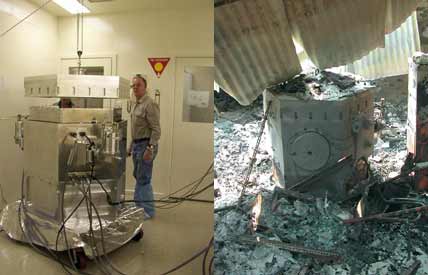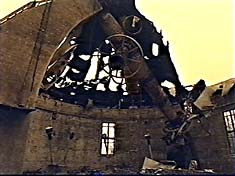
The Near-Infrared Integral-Field Spectrograph (NIFS) was only months from completion when a bush fire roared across the Mount Stromlo Observatory and destroyed the instrument as well as five major telescopes and thier buildings. The cost to reconstruct the spectrograph will be covered by insurance, and the Australian National University plans to deliver a rebuilt instrument to Gemini Observatory in Hawaii in early 2005.
Left:Courtesy Australian National University. Right: Courtesy Matthew Colless (ANU).
Among those who work at Mount Stromlo Observatory outside Canberra, Australia, January 18th is known as Black Saturday. During a record-breaking hot, dry, Australian summer, a lightning strike touched off a raging forest fire. When the fire was finally extinguished, the inferno had destroyed more than 500 homes, killed four people, and left the telescopes atop Mount Stromlo in ruins. In one afternoon, the observatory lost its five main telescopes, the main administration building, library, and workshops, as well as the homes of eight staff members. Only the visitor's center and two buildings containing computerized archives survived. Perhaps the greatest single loss was the Gemini Near-Infrared Integral-Field Spectrograph (NIFS), a $2.5 million instrument, which was undergoing its final testing and was within months of delivery to the Gemini Observatory 8-meter Gillett telescope atop Mauna Kea, Hawaii.
Just three weeks later, the astronomers and staff of Stromlo were back on the mountain, working at full tilt. With NIFS destroyed beyond repair, the engineers focused their attention toward another contract for Gemini Observatory, the multi-million-dollar Gemini South Adaptive Optics Imager (GSAOI). In early December, the Australian National University (ANU) won a competition to build the imager — a contract they will continue to hold despite the fire.
"We are definitely going head with GSAOI at the Australian National University," says Doug Simons, the associate director for instrumentation at Gemini Observatory. The GSAOI team will use the surviving office building at Stromlo and a few temporary buildings as the site is restored.

As this television image shows, little remained of the 26-inch Yale-Columbia refractor after fire swept through Mount Stromlo Observatory. Built in 1924 and first used in South Africa to measure star distances, the venerable telescope was moved to Australia in 1952.
Courtesy Steve Massey.
NIFS, it seems, is also rising from the ashes. The replacement cost of the instrument was insured by ANU. Predicated on the insurance settlement, says Simons, Gemini Observatory has given ANU the approval to rebuild NIFS. What's more, in a bit of black humor, the instrument's state-of-the-art science detector was held up in Sydney in customs during the fire and arrived on the mountain four days after the disaster. It is in perfect working order and ready to be incorporated into a reconstructed instrument.
To speed the process, the University opted to subcontract out the rebuild project to an aerospace firm. Among the few things spared from the fire were the NIFS drawings and schematics, and the contractor will use them to build the device to the state it was at before the fire. Then the university will finish the job and commission the instrument on Mauna Kea sometime in early 2005.
 0
0
Comments
You must be logged in to post a comment.